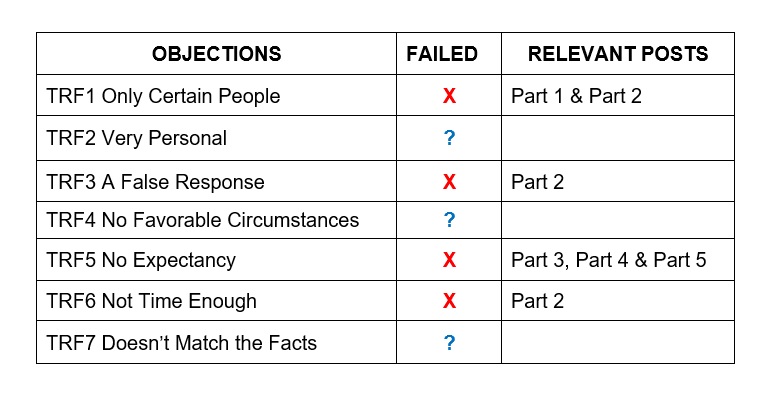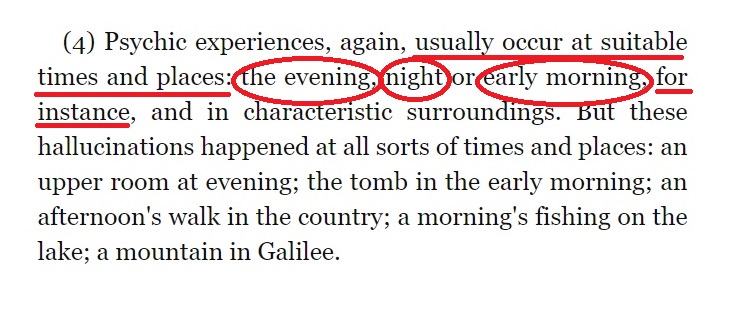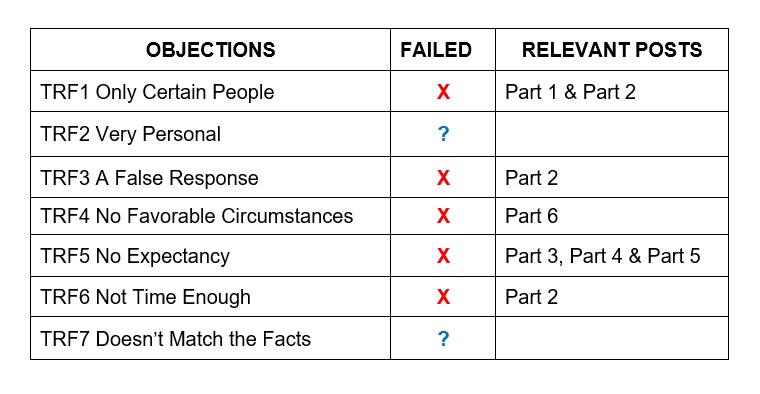Did Jesus Rise from the Dead? Part 6: The NO FAVORABLE CIRCUMSTANCES Objection (TRF4)
WHERE WE ARE
In the previous five posts of this series, I have shown that the best case scenario (for Christian apologetics) is that MOST of Josh McDowell’s objections against the Hallucination Theory in his book The Resurrection Factor (hereafter: TRF) are WORTHLESS CRAP:
One problem that I pointed out with Objection TRF5 (No Expectancy) is that the word “usually” in the revised and improved version of that objection is VAGUE. My use of the word “MOST” is similarly vague, but I can quantify my point in a fairly precise way. At least four out of seven of McDowell’s objections against the Hallucination Theory are WORTHLESS CRAP, which means that at least 57% of McDowell’s objections against the Hallucination Theory are WORTHLESS CRAP.
Furthermore, (***SPOILER ALERT***) after taking a few minutes to read and think about Objection TRF4 (No Favorable Circumstances), I realized that this objection was also a stinking pile of WORTHLESS CRAP. So, now I am confident that at least five out of seven of McDowell’s objections against the Hallucination Theory are WORTHLESS CRAP. That means that at least 71% of McDowell’s objections against the Hallucination Theory are WORTHLESS CRAP!
It is tempting to conclude that ALL of McDowell’s objections against the Hallucination Theory are WORTHLESS CRAP. However, I intentionally saved his best objections for last. The final two objections raised by McDowell are not as clearly and obviously mistaken as the previous objections, at least in my view. So, it is still possible that McDowell has one or two solid objections against the Hallucination Theory. But neither of the remaining two objections strike me as strong or solid objections, so I won’t be surprised if, on closer examination, they also turn out to be WORTHLESS CRAP.
In any case, if I am correct at least 71% of McDowell’s objections against the Hallucination Theory are WORTHLESS CRAP, it appears that he is about as bad at identifying good arguments as are the apologists Peter Kreeft and Norman Geisler. These three Christian apologists have almost NO ABILITY to distinguish between a good argument and a bad one (or else they simply don’t care about the quality of their arguments).
I suspect that their inability to distinguish between a good argument and a bad one is largely the result of decades of experience preaching to the choir. White Evangelical Christians are, in general, dumber than a sack of hammers, and have little intellectual ability or objectivity. The audience that these apologists write for, and speak to, will gladly accept ANY arguments for Christian beliefs, no matter how crappy and pathetic those arguments might be. Because their audience is without intellectual ability or integrity, these apologists never needed to learn how to distinguish between a good argument and a bad one. The Evangelicals that they preach to are just as happy with crappy and defective arguments for their beliefs as they are with solid and logical arguments for those beliefs.
PROBLEM #1 WITH TRF4 (NO FAVORABLE CIRCUMSTANCES): VAGUENESS & UNCLARITY
McDowell’s general approach in his attempt to refute the Hallucination Theory is to make use of a psychological principle or an empirical generalization concerning hallucinations and then argue that the circumstances of the “appearances” of the risen Jesus don’t fit the conditions/requirements described by one of those psychological principles:
Why is the hallucination theory so weak?
First, it contradicts various conditions which most psychiatrists and psychologists agree must be present to have a hallucination. (TRF, p.84)
Objection TRF4 fits this general strategy adopted by McDowell. Here is how he describes the psychological principle used in this “No Favorable Circumstances” objection:
Another principle of hallucinations is that they usually are restricted as to when and where they can happen. In the New Testament situations, favorable circumstances are missing. …
…Indeed, the variety of times and places of Christ’s appearances defies the hypothesis that they were mere visions. (TRF, p.85)
This alleged “psychological principle” is so VAGUE and UNCLEAR that McDowell’s claim that it represents “conditions which most psychiatrists and psychologists agree must be present to have a hallucination” is clearly and obviously pure BULLSHIT.
I doubt that any psychological expert on hallucinations would ever publish a scientific article in a peer-reviewed journal or book that contained such a VAGUE and UNCLEAR “psychological principle”, but I’m absolutely certain that such a VAGUE and UNCLEAR statement would never in a million years be accepted by “most psychiatrists and psychologists”. This alleged “psychological principle” is an idea that only an audience of brain-dead White Evangelical Christians would find reasonable.
There are actually two VAGUE principles asserted by McDowell above:
Restricted Times Principle: Hallucinations usually are restricted as to when they can happen.
Restricted Places Principle: Hallucinations usually are restricted as to where they can happen.
As we previously saw with the revised first premise of Objection TRF5 (No Expectancy), the term “usually” is very VAGUE. Does this mean “more than 50% of hallucinations” or “more than 60% of hallucinations” or “more than 70% of hallucinations” or “more than 80% of hallucinations” or “more than 90% of hallucinations”? There is a huge difference between “more than 50% of hallucinations” being restricted to certain times, as compared with “more than 90% of hallucinations” being restricted to certain times. Furthermore, even if we are talking about 70% or 80% of hallucinations being restricted to certain times, this objection would be weak, because that means that 2 or 3 out of 10 hallucinations could occur outside of those certain times, without there being ANY conflict with this supposed “principle”!
Next, the phrase “restricted as to when they can happen” is itself very VAGUE and UNCLEAR. Is McDowell talking about time of day? (e.g. morning, afternoon, evening, nighttime) or time of the month? (e.g. early in the month, middle of the month, last week of the month) or time of the year? (e.g. winter, spring, summer, fall)? Or is he talking about the cycle of daily events? (e.g. while eating breakfast, while taking a shower, while getting dressed, while driving to work, while at work, while driving home, while eating supper, while getting ready for bed, while going to sleep, etc.)
Although McDowell does not specify this, it seems that he had in mind restrictions as to the time of day (e.g. morning, afternoon, evening, nighttime), because he mentions that there was one “early morning appearance” of the risen Jesus, and that there were a couple of appearances “in broad daylight” (TRF, p.85). Assuming this is what he had in mind, McDowell doesn’t bother to tell us what the “proper” times are for hallucinations to occur.
Do hallucinations usually happen in the “early morning”? If so, then why mention the examples of appearances of Jesus in the morning? Do hallucinations usually happen in the afternoon? If so, then why mention examples of appearances of Jesus “in broad daylight” (suggesting late morning or afternoon). Because he FAILS to specify the time of day (or times of day) when hallucinations “usually” happen, his alleged “psychological principle” is WORTHLESS for use in evaluation of the Hallucination Theory.
McDowell’s Restricted Places Principle is also very VAGUE and UNCLEAR, and thus WORTHLESS for use in evaluating the Hallucination Theory:
Restricted Places Principle: Hallucinations usually are restricted as to where they can happen.
What sort of restriction does McDowell have in mind here? He does not say. Does he think hallucinations usually occur in California but not in Florida or Texas? That is absurd and obviously false. Does he think that hallucinations usually occur in grocery stores and restaurants but not in department stores or gas stations? That is equally ridiculous. Does he think hallucinations usually occur in dining rooms and living rooms but not in kitchens or bathrooms? Does he think that hallucinations usually occur on land but not at sea and not on lakes or rivers? Does he think that hallucinations usually occur in valleys but not on hills or mountains? What the HELL are the “restrictions” on the location where hallucinations occur? Why would hallucinations be impacted by location or geography anyway? This “psychological principle” is so VAGUE and UNCLEAR that it is WORTHLESS for use in evaluating the Hallucination Theory.
So, both of the “psychological principles” that are the foundation of Objection TRF4 are WORTHLESS for use in evaluating the Hallucination Theory, and therefore this objection FAILS.
PROBLEM #2 WITH TRF4 (NO FAVORABLE CIRCUMSTANCES): ZERO EVIDENCE
The extreme VAGUENESS and UNCLARITY of McDowell’s two “psychological principles” upon which Objection TRF4 are based, strongly indicates that his claim that these principles describe “conditions which most psychiatrists and psychologists agree must be present to have a hallucination” is pure BULLSHIT.
In order to provide actual EVIDENCE that these two alleged “psychological principles” are widely accepted by psychological experts (or that these principles are true), McDowell would need to provide several quotations from peer-reviewed scientific articles and/or books written by various psychological experts who have specific knowledge about hallucinations and the causes of hallucinations.
- How many psychological experts does McDowell quote in support of these two “psychological principles” in The Resurrection Factor? ZERO!
- How many psychological experts does McDowell quote in support of these two “psychological principles” in Evidence that Demands a Verdict? ZERO!
- How many psychological experts does McDowell quote in support of these two “psychological principles” in Evidence for the Resurrection? ZERO!
- How many psychological experts does McDowell quote in support of these two “psychological principles” in The New Evidence that Demands a Verdict? ZERO!
In short, McDowell makes no effort whatsoever to provide any actual EVIDENCE to support these two key factual claims upon which Objection TRF4 is based. Given that these claims are so VAGUE and UNCLEAR that it is practically certain that they do NOT describe “conditions which most psychiatrists and psychologists agree must be present to have a hallucination”, the complete and total lack of relevant EVIDENCE is more than enough reason to seriously doubt and reject the two alleged “psychological principles” behind Objection TRF4, and therefore this objection FAILS.
PROBLEM #3 WITH TRF4 (NO FAVORABLE CIRCUMSTANCES): CLARIFICATION RESULTS IN FAILURE
McDowell did not originate Objection TRF4. He learned this objection from another Christian apologist named J.N.D. Anderson. In Evidence that Demands a Verdict, when McDowell presents Objection TRF4, he cites a long essay written by Anderson called The Evidence for the Resurrection, which was first published in 1950, more than twenty years prior to publication of Evidence that Demands a Verdict, and more than thirty years prior to publication of The Resurrection Factor.
In fact, five out of the seven objections that McDowell raises against the Hallucination Theory came from Anderson’s long essay (TRF1, TRF2, TRF4, TRF5, and TRF6). The contents of the objections by Anderson not only closely parallel the objections as stated by McDowell in TRF, but they occur in nearly same order in Anderson’s essay on the resurrection as in McDowell’s The Resurrection Factor. (NOTE: the same five objections are also found in Know Why You Believe by Paul Little and they also occur in nearly the same order as in Anderson’s essay, but Know Why You Believe was first published in 1967, so Anderson’s essay was probably the original source of these objections for both McDowell and Little.)
I read Anderson’s presentation of Objection TRF4 (No Favorable Circumstances) to see if it shed any light on the VAGUE and UNCLEAR “psychological principles” that this objection is based upon. Anderson’s discussion and use of the Restricted Times Principle is quite revealing:
In this context, the phrase “psychic experiences” refers to hallucinations. Unlike McDowell, Anderson actually SPECIFIES EXAMPLES of times when hallucinations “usually occur”: (a) evening, (b) night, and (c) early morning. The problem here is that these periods of time account for a significant portion of the hours in a day. What is left out is late morning and early afternoon. But Anderson FAILS to explicitly state that it is unusual for hallucinations to occur in late morning or in the early afternoon. He only provides us with some examples of periods of time when hallucinations (allegedly) “usually occur”. But what we really need to know is the times of day when hallucinations usually DO NOT occur!
Furthermore, most of the examples of appearances of Jesus that Anderson provides as evidence against the Hallucination Theory are appearances that occurred during the very times of day that Anderson tells us are when hallucinations “usually occur”! He mentions an appearance of the risen Jesus in “an upper room at evening”, but evening is one of the times of day when Anderson says hallucinations “usually occur”. He mentions an appearance of the risen Jesus at “the tomb in the early morning”, but early morning is one of the times of day when he says hallucinations “usually occur”. He mentions an appearance of the risen Jesus during “a morning’s fishing on the lake”, but he says that early morning is one of the times of day when hallucinations “usually occur”. Anderson mentions only ONE appearance of the risen Jesus that does not occur during one of the times of day that he stated as being when hallucinations “usually occur”: an appearance that happened during “an afternoon’s walk in the country”. Anderson does NOT state that it is unusual or uncommon for hallucinations to occur in the afternoon.
But even if Anderson intended to claim that MOST hallucinations occur in the evening, night, or early morning, and that it is uncommon for hallucinations to occur in the afternoon, the examples of appearances of the risen Jesus that are given by Anderson FIT THAT PROFILE! Most of his examples are appearances that occurred in the evening, night, or early morning. Only one example that he gives is an appearance that took place in the afternoon. So, the examples that Anderson provides UNDERMINE his own objection; the examples of alleged appearances of the risen Jesus conform to the Restricted Times Principle that Anderson uses in his presentation of Objection TRF4.
So, we can either stick with McDowell’s version of the Restricted Times Principle and conclude that Objection TRF4 FAILS because it is so VAGUE and UNCLEAR that it is WORTHLESS for use in evaluating the Hallucination Theory, or else we can go back to the original presentation of Objection TRF4 in Anderson’s essay (The Evidence for the Resurrection), which presents a clearer and somewhat more useful version of the Restricted Times Principle, and then reasonably conclude that the Hallucination Theory is NOT contrary to this principle, and thus that Objection TRF4 FAILS. Either way, the objection FAILS.
CONCLUSION
Objection TRF4 (No Favorable Circumstances) is the fourth objection against the Hallucination Theory presented by Josh McDowell in The Resurrection Factor, and it is the fifth objection from McDowell that I have examined so far. I have given three good reasons showing that this objection FAILS.
First, the alleged “psychological principles” upon which this objection is based are very VAGUE and UNCLEAR, making those principles WORTHLESS for an evaluation of the Hallucination Theory. Second, McDowell provides ZERO evidence in support of his two key “psychological principles”. Third, this objection originated (for McDowell) with the 1950 essay The Evidence for the Resurrection by J.N.D. Anderson, and that essay provides a somewhat clearer and more useful version of one of McDowell’s “psychological principles” (i.e. the Restricted Times Principle). But Anderson’s application of that clarified principle reveals (contrary to what Anderson believed) that the alleged appearances of the risen Jesus are NOT contrary to, or in conflict with, that supposed psychological principle. So, if we clarify that key psychological principle according to how this objection was originally presented by Anderson, then the objection still FAILS.
I conclude that Objection TRF4 (No Favorable Circumstances) FAILS. In Part 1 through Part 6 of this series, I have now shown that five out of seven (or at least 71%) of McDowell’s objections against the Hallucination Theory FAIL:
That leaves us with only Objection TRF2 and Objection TRF7. Although there is still a chance that one or both of those objections is a good and solid objection to the Hallucination Theory, the fact that five out of seven of McDowell’s objections have FAILED is a clear indication that McDowell has little or no ability to distinguish between a good argument and a bad one (or else that he just doesn’t give a damn about the quality of his arguments).
Also, given that no other Christian apologists who present similar objections against the Hallucination Theory provide any relevant EVIDENCE to support the alleged “psychological principles” upon which these objections are based, we can also reasonably conclude that many (most?) Christian apologists either lack the ability to distinguish between a good argument and a bad one or else they just don’t give a damn about the quality of their arguments.




